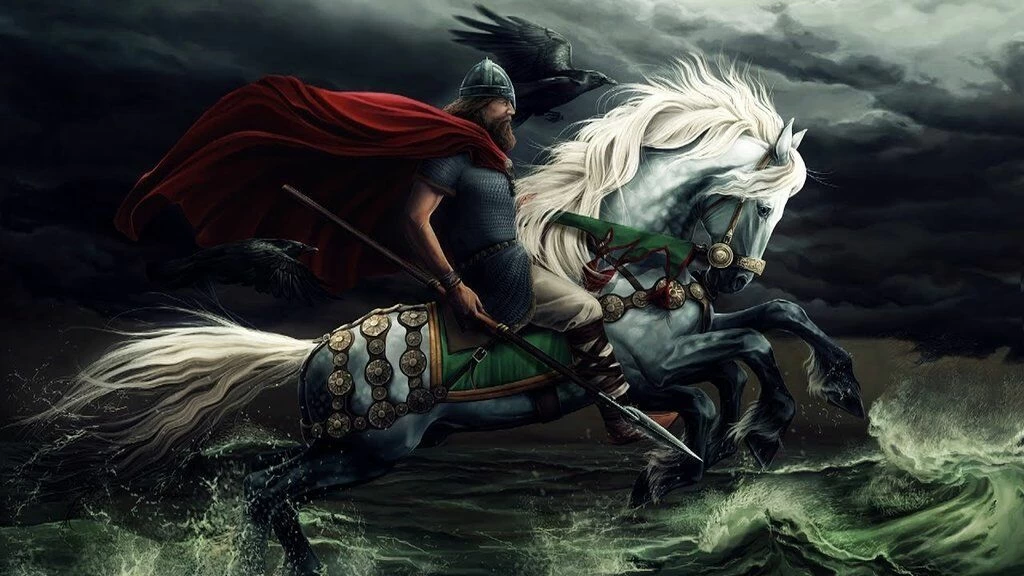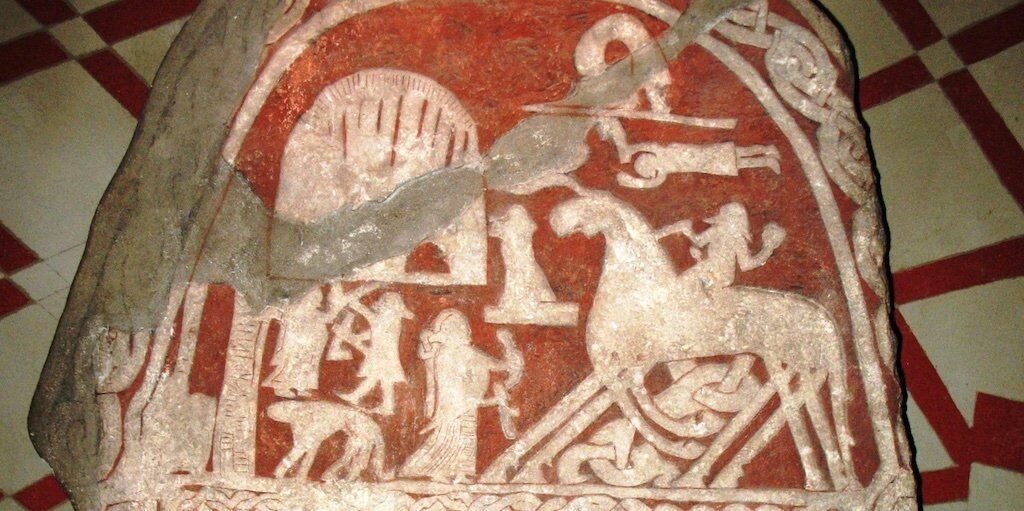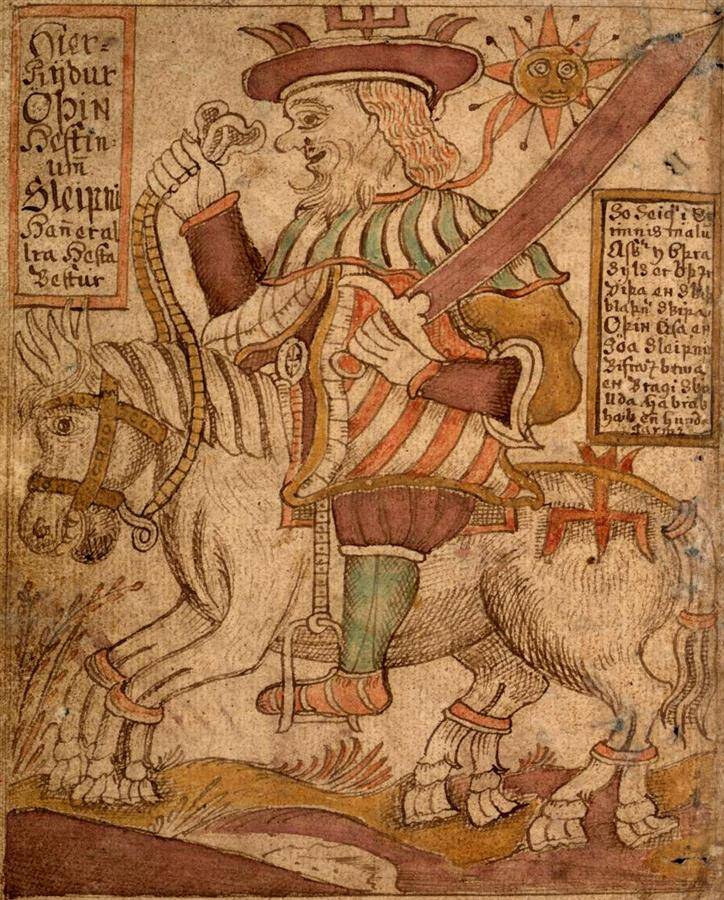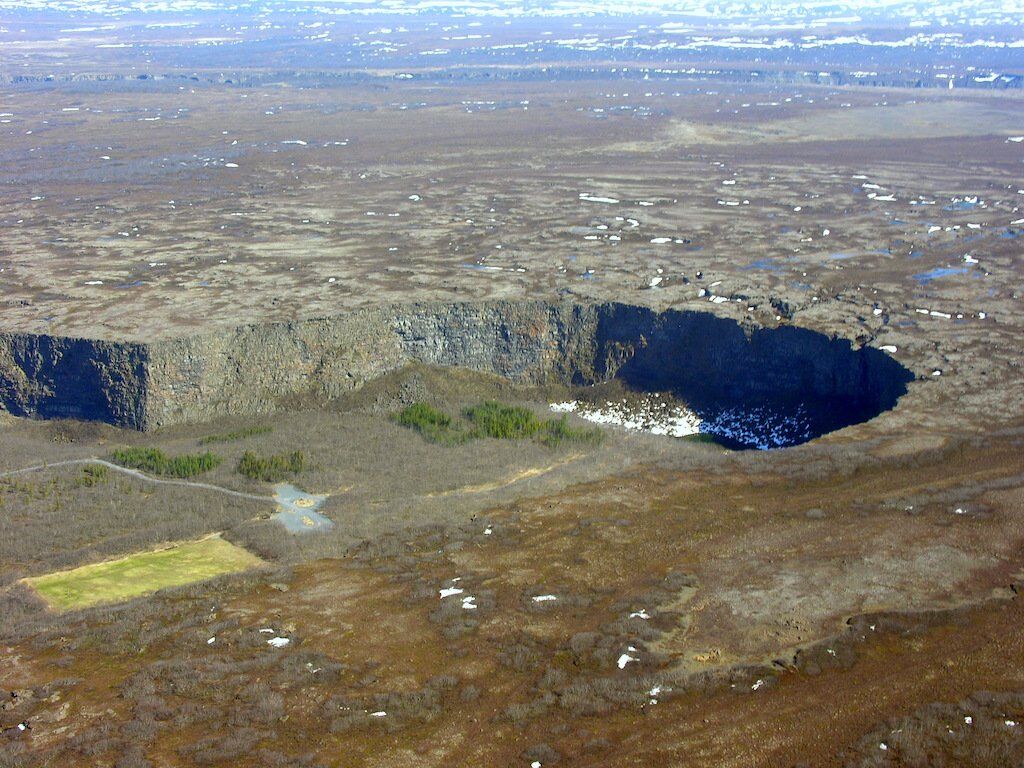In Norse Myth, What Animal Was The 8-legged Sleipnir?
Norse mythology offers modern readers a wondrous globe of giants, elves, monsters, and a massive ash tree, Yggdrasil, that connects nine encircling universal realms. The Aesir, including Odin, Thor, Loki, Heimdall, and Freyr, oversee these worlds aslope a panoply of sentient and powerful animals. Few of these creatures is as well-known as Sleipnir, the eight-legged horse of Odin.

Origin
The name Sleipnir means something akin to "Fast-Traveler." His name derives from the Erstwhile Norse describing wordsleipir, meaning slick or slippery. TheProse Edda, composed by Snorri Sturluson, a thirteenth-century Icelandic poet, historian, and chieftain, documents Sleipnir'due south most unconventional origins. According to Snorri, the great equus caballus was sired by a remarkable stallion named Svaðilfari. However, Sleipnir was born of no normal mare. The mare who bore the mystical steed was none other than Loki. That'southward correct – Loki, the trickster god, adopted son of Odin and brother of Thor. A notorious shapeshifter, Loki perhaps got more he bargained for in this episode.
Yous May As well Similar: Mysteries of Surt's Cave: Bandits, Mutilations, and the Fire Behemothic
Loki and Svaðilfari
Like many Norse stories, the nascence of Sleipnir begins with a feisty giant. In the early days of Asgard, post-obit a war between the gods, a giant offered to build a massive protective wall around Asgard, promising completion inside a year. His payment would exist Freyja, goddess of dear and beauty, as well every bit the sun and the moon. Convinced the chore was incommunicable in such a timeline, the gods agreed, unaware of the behemothic horse Svaðilfari, who helped the builder by moving massive stones with lightning speed. Only 3 days before the wall was completed, cunning Loki shapeshifted, condign a mare in oestrus. As the mare, Loki lured Svaðilfari far from the wall, foiling the behemothic's deal. Shortly later a forest consummation with Svaðilfari, Loki gave birth to Sleipnir, the eight-legged colt.

Sleipnir'south 8 legs?
Sleipnir is easily identified in Norse art, as on Sweden's Tjängvide and Ardre Eight picture stones. With 8 legs, Sleipnir would exist faster than any other horse, suited for the king of the gods himself. Historian Hilda Ellis Davidson has speculated that the stallion's 8 legs could be symbolic of a shaman's afterlife journeying. This wonderous steed's eight legs equaled the number of legs of a standard set of litter-bearers. Four men conveying a catafalque – taking a soul to another world – also stand upon viii legs. Odin's amalgamation with the afterlife lends credence to this idea.
Adventures
The magnificent grey stallion appears in many Old Norse texts including, thePoetic Edda, theSaga of the Volsungs, and more. In every story, this swiftest of horses was true to his proper name. Every bit Odin's favorite ways of travel, Sleipnir non but traveled by state but could fly through the air. Equus caballus and master undertook all manner of adventures, such as racing against the giant Hrungnir and his horse Gullfaxi (Gilded-mane). Hermod, son of Odin, rode Sleipnir over the bridge Gjallarbru to Hel, seeking, unsuccessfully, to resurrect the beloved god Baldr following his untimely decease.

Odin's Other Animals
Wherever Odin the Allfather went, his animal allies were nearby. Sleipnir, the greatest of all horses, carried Odin throughout the 9 realms, including a daily ride across Bifrost, the rainbow span connecting the divine realm Asgard with Midgard, the Earth. Other animals attended to and communicated with the Loftier God Odin. He is frequently pictured sitting in splendor in Asgard'due south nigh famous hall, Valhalla. Always near his side are Huginn and Muninn, the ravens also known as "thought" and "memory." The ravens fly around Midgard and across, bringing reports dorsum to Odin's ears from afar. Two wolves, Gerir and Freki, "the ravenous," likewise sit alongside the king of the gods.
Horses of the Gods
Like any great stallion, Sleipnir sired generations of horses, including Grani, the horse of Sigmund of the Volsungs. No other steed rivals Sleipnir, only the Norse gods also had horses of slap-up repute. TheCarol of Grimnir, part of thePoetic Edda, names x horses of the gods, albeit without whatsoever specific owners or riders. Nótt, the goddess of Night, and her son Dagr, or Day, as well rode horses effectually the universe. Dark rode Hrímfaxi (Frost Mane), whose spittle barbarous nightly upon the earth. 24-hour interval rode Shining Mane, Skinfaxi, whose mane lit up both earth and sky. Never to follow the crowd, the mighty god Thor eschewed horses, choosing instead to walk across Bifrost or, in some stories, to use his magic goats Tanngrisnir (snarler) and Tanngnjóstr (gnasher) to draw his chariot.
Y'all May Also Similar: Important Norse Symbols and Their Meaning
Other Animals in Norse Mythology
Animals were more than livestock and pets in Norse myths. They were sentient beings and forces in the universe. The Norse universe, like about mythological worlds, bristled and bustled with all fashion of creatures. The giant world tree Yggdrasil was dwelling house to many marvelous animals. At its crown sat a behemothic eagle with a slightly less giant hawk perched between its optics. The chittering squirrel Ratatosk scurried the heights of Yggdrasil, conveying words from the eagle to the serpent Nidhogg who lived at the base of operations of the great tree, gnawing at its roots. Along with four great stags, Nidhogg threatened to topple over Yggdrasil. Other monsters, like the giant wolf Fenrir and Jörmungander, the world serpent, threaten the gods and heroes at Ragnarök.
Horses in Icelandic Archaeology
Ownership of horses, the four-legged kind, was essential for any homo of worth in Norse club. Throughout the dozens of Icelandic sagas, horses appear every bit valued labor and property across the North Atlantic world. Horse trappings and remains are found in burials beyond the Norse world.
You lot May Also Similar: Did Knights Templar Hide the Holy Grail in Iceland?
A contempo archaeological study reveals that powerful men of Viking-Age Iceland went to the afterlife with sacrificed stallions, as revealed by Dna analysis of horse teeth and basic found in loftier-status graves. Horse skulls are also found buried within houses, perchance affiliated with luck or protection. Horse cults may accept existed across the medieval Scandinavian world.
Sleipnir in Popular Culture

Archaeologists accept yet to find physical evidence for any eight-legged horses, only Sleipnir'southward presence is however seen in Iceland today. Legend holds that Sleipnir formed the horseshoe-shaped canyon, Ásbyrgi, in the north of Iceland, by dragging a hoof too close to the earth. Fans of Marvel Comics and the popular video game Gods of War will be familiar with Sleipnir equally a powerful companion of Odin.
Bibliography
Some of these references contains chapter links. If you employ these links to purchase something nosotros may earn a commission.
H. R. Ellis Davidson,Gods and Myths of Northern Europe (Penguin Books, 1990).
John Lindow,Norse Mythology: A Guide to the Gods, Heroes, Rituals, and Beliefs (Oxford University Printing, 2001).
Anne Monikander, "Sleipnir and his Siblings: Some Thoughts on Loki's Monstrous Offspring," inPlaces in Between: The Archaeology of Social, Cultural and Geographical Borders and Borderlands.
Borderlands. Ed. David Mullin (Oxbow Books, 2011), pp 58-66.
Snorri Sturluson,The Prose Edda, trans. Jesse Byock (Penguin, 2005).
Source: https://www.historicmysteries.com/sleipnir-mythic-eight-legged-horse-of-odin/
Posted by: martinezthilvely.blogspot.com

0 Response to "In Norse Myth, What Animal Was The 8-legged Sleipnir?"
Post a Comment